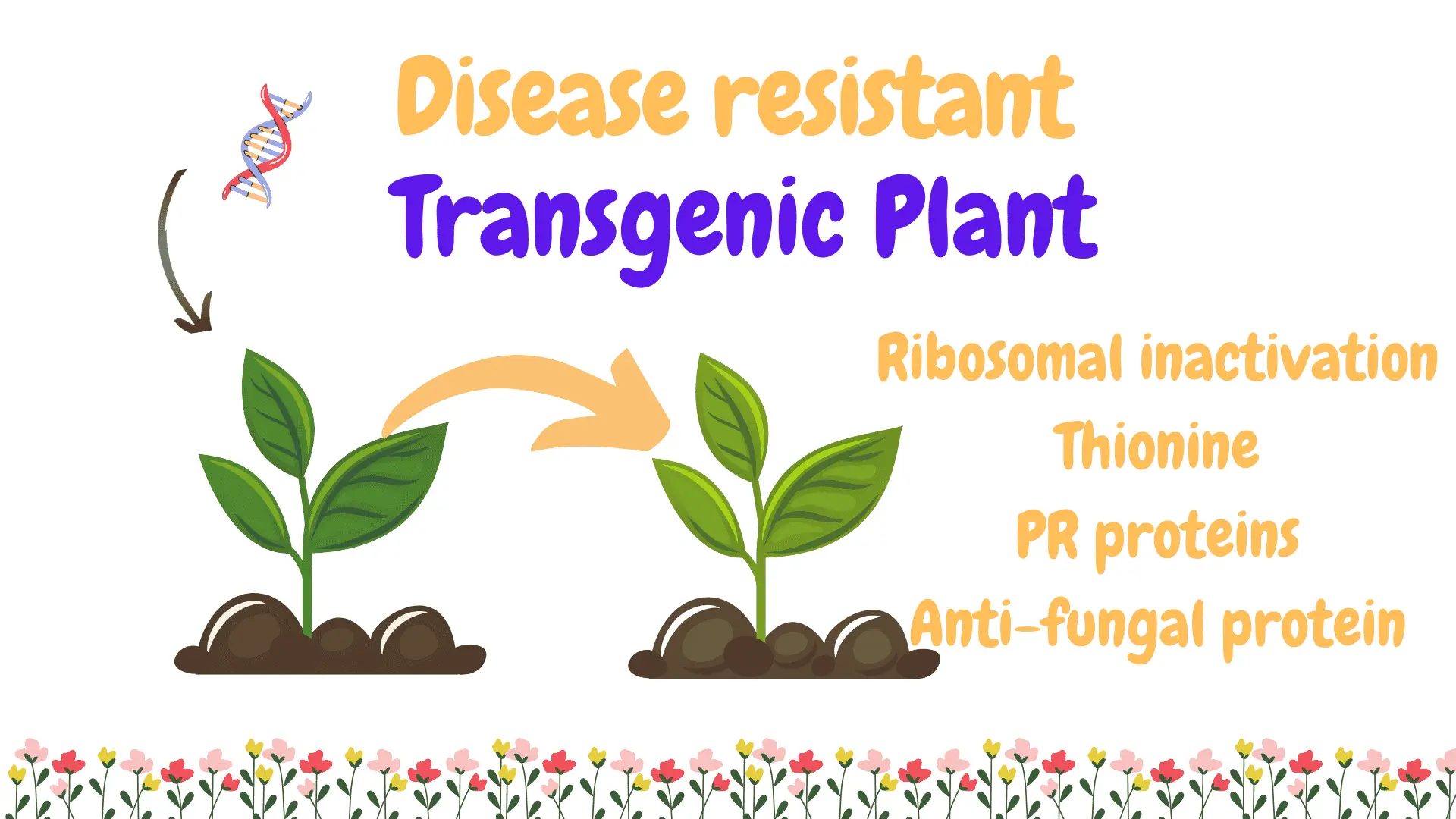Disease resistance Transgenic plants are the plants created through genetic engineering by transferring desired gene into target plant or crops to enhance their ability to resist specific pathogens.
Table of Contents
Ribosome-Inactivating Proteins
- RIPs are N-glycosidase enzymes, closely related to cytotoxin lectins like ricin, found in certain plant species.
- RIPs inhibit protein synthesis by removing a specific adenine residue in the 28S rRNA of ribosomes, halting translation in target cells.
- RIPs do not inactivate the plant’s own ribosomes. They have varying effects on the ribosomes of different species (e.g., fungi), suggesting specificity based on differences in the 28S rRNA structure and its substrate.
- Barley RIPs have shown potential to inhibit fungal growth synergistically when combined with cell wall-degrading enzymes like cellulases and glucanases.
- RIP expression is developmentally regulated in barley, particularly in the starchy endosperm during seed development (experessed).
Example – experiment
- To test if barley RIP expression enhances fungal resistance, transgenic tobacco plants were created.
- Barley RIP gene was placed under the control of a wound-inducible promoter from the potato “wun1” gene.
- Transgenic plants produced RIP mRNA and proteins upon wounding, and showed significant resistance to fungal infection by Rhizoctonia solani.
Expression of Heterologous α-Thionins
- Thionins (5000Da) is Small, cysteine-rich proteins with toxic effects on pathogens. They are thought to contribute to plant resistance against fungal and bacterial pathogens.
- Structure: Thionins are synthesized as precursors with a signal peptide and an acidic C-terminal sequence.
- Thionins are found in the endosperm and leaves of cereals, and have also been reported in roots and other plant species.
- In leaves, thionins are located in both the vacuole and the extracellular space (apoplast). Normally present in good amount but increased in response to pathogenic infection
- Expression in Transgenic Plants: Transgenic tobacco plants expressing barley or wheat thionin genes under the 35S CaMV promoter showed reduced lesion development when infected with Pseudomonas syringae.
- Observations: Higher thionin levels correlated with increased pathogen resistance, although the protection was incomplete.
Ectopic Expression of PR Proteins
- Plants use various cellular processes to resist pathogen infections and limit disease spread. Upon detecting a pathogen, plants trigger multiple defense mechanisms locally or systemically, including localized cell death (hypersensitive response), callose deposition, cell wall thickening (lignification), production of antibiotic compounds and synthesis of pathogenesis-related proteins.
- Pathogenesis-Related (PR) Proteins : These proteins are involved in systemic acquired resistance (SAR), which is triggered by pathogen infection or chemicals like salicylic acid.
- They include chitinases and glucanases, which degrade fungal cell walls.
- Example: Constitutive Expression of PR Proteins (PR1 proteins), induced during tobacco mosaic virus (TMV) infection, accumulate significantly upon induction.
- Ectopic expression of PR1 proteins in transgenic plants provided partial protection against fungal pathogens like Peronospora tabacina (blue mold) and Phytophthora parasitica (black shank).
Among the most well-characterized pathogenesis-related (PR) proteins are those exhibiting chitinase and β-1,3-glucanase activities. These proteins typically exist in two isoforms across many plant species: an acidic isoform located in the extracellular space (apoplast) and a basic isoform that accumulates intracellularly within the vacuole.
Chitinases
- Chitinases break down chitin, a key component of fungal cell walls, making them a crucial defense protein.
- Chitinases catalyze the hydrolysis of chitin, a beta-1,4 linked polymer of N-acetyl-D-glucosamine which is a major cell wall component of most filamentous fungi with the exception of the Oomycetes
- Types: Class I chitinases (vacuolar) are antifungal, whereas Class II (extracellular) have limited or no antifungal activity.
- chitinases are generally found at low levels in healthy plants, their expression drastically increases during pathogen attack or treatment with chemicals, such as salicylic acid, that induce a systemically acquired resistance
- homologous to class I, are located in the extracellular space and do not have antifungal activity either alone or in combination with other proteins.
How Disease resistance Transgenic plants are made:
- Identification of Resistance Genes: Scientists identify genes from other organisms, such as plants, bacteria, or viruses, that confer resistance to diseases. These genes encode proteins or molecules that can recognize and defend against pathogens.
- Gene Insertion: The identified resistance gene is inserted into the genome of the target plant. This is typically done using techniques like Agrobacterium-mediated transformation, where the bacteria transfers the gene into the plant’s DNA, or via gene guns, which physically shoot DNA into plant cells.
- Regeneration: The modified plant cells are then grown into full plants through tissue culture techniques. These plants will have the new gene incorporated into their genome.
- Testing: The transgenic plants are tested for disease resistance and to ensure that the insertion of the new gene does not negatively impact the plant’s growth or development.
References
Herrera-Estrella, L., Simpson, J., & Martínez-Trujillo, M. (2004). Transgenic plants: an historical perspective. Transgenic plants: methods and protocols, 3-31.
